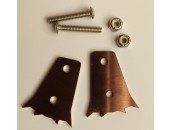Sledge Hockey
Sledge hockey is a sport that was designed to allow participants who have a physical disability to play the game of ice hockey. Ice sledge hockey (also known as sled hockey in the United States) was invented in the early 1960s in Stockholm at a rehabilitation centre. It is currently one of the most popular sports in the Paralympic Games.
Although there are many restrictions to the measurements and weight of the sledges used in the Paralympic Games, not a whole lot has changed from the original design to the ones that exist today. Most of the typical ice hockey rules are followed with the exception some of the equipment. Players sit in specially designed sleds that sit on top of two hockey skate blades. There are two sticks for each player instead of one and and the sticks have metal pics on the butt end for players to propel themselves.
Sled accessible rinks allow players to remain in their sleds and skate off the ice into the bench area. This requires that the bench area is flush with the ice and there is clear plexiglass replacing the white boards.
International competition between sledge hockey teams started up in 1969 that included five teams out of Europe. In 1981, Great Britain established their first sledge hockey team, and that was shortly followed by Canada in 1982. It was not until 1990 that the United States developed their first ice sledge hockey team and sledge hockey continued to expand when Estonia and Japan developed their teams in 1993. International ice sledge hockey became an official event in 1994 for the beginning of the Paralympic Games:
Sled hockey provides opportunity for many types of disabilities (and none) and there are opportunities available in local areas for recreation/competition all the way to the National Sled Team that plays in the Paralympics.





























